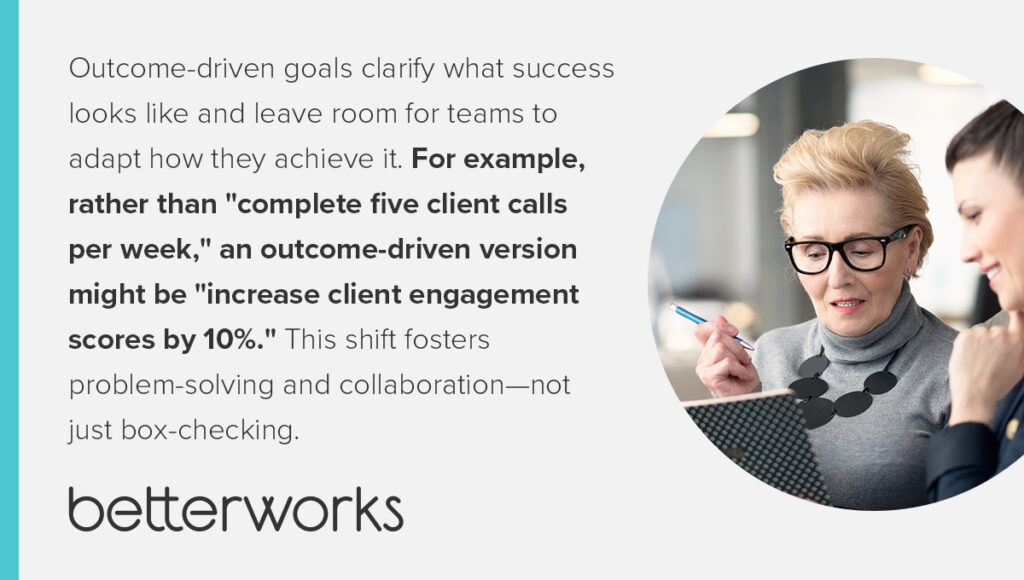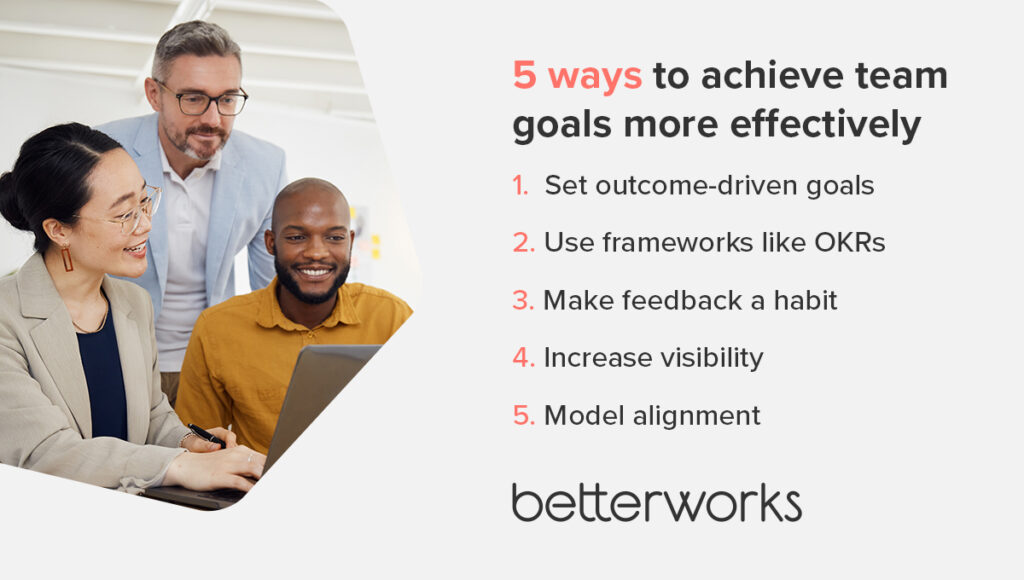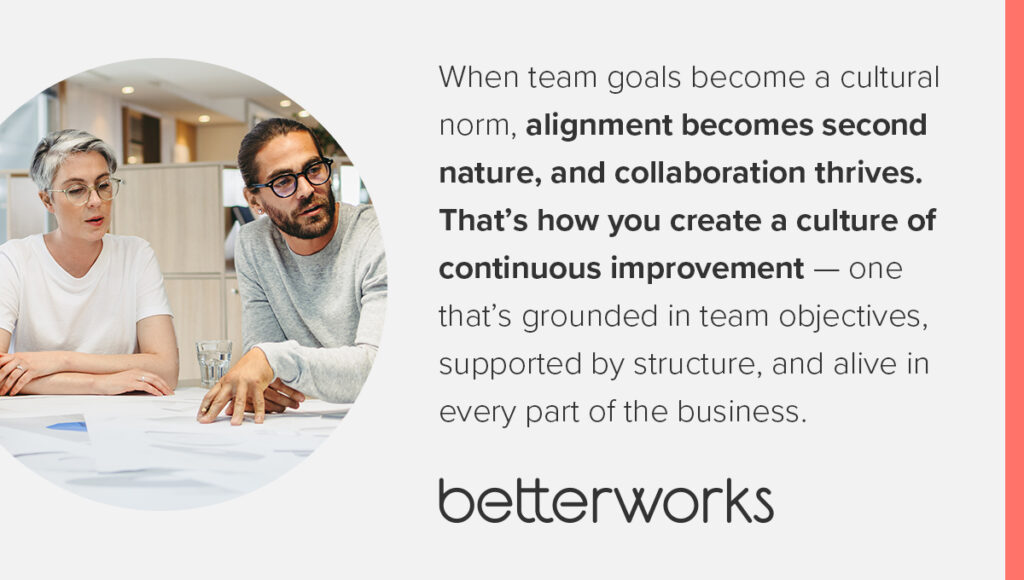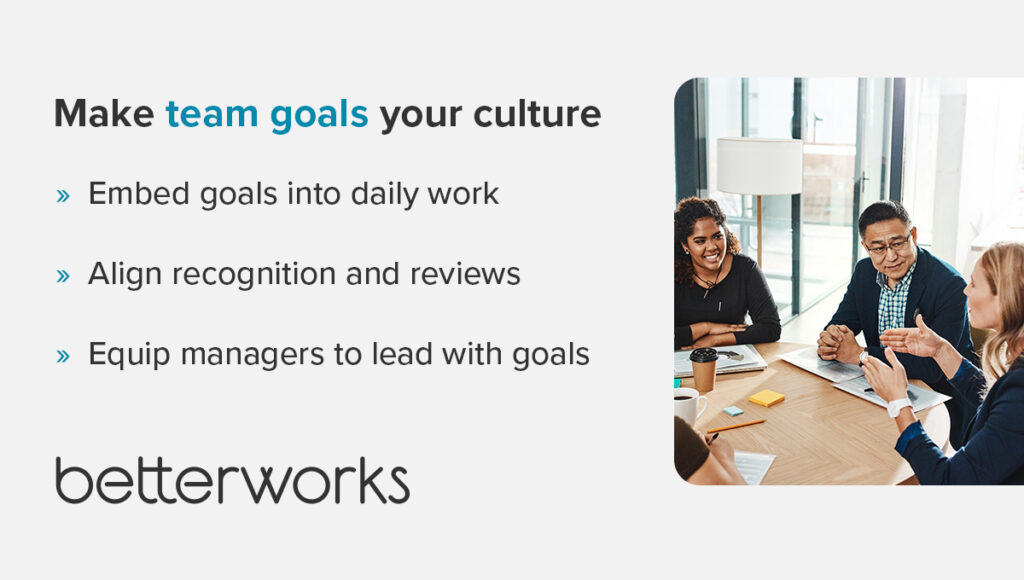Team development goals are essential because high-performing individuals don’t always make high-performing teams. Misalignment across teams leads to stalled initiatives, duplicate work, and wasted energy — and your managers are the ones stuck navigating the chaos without a roadmap.
The result? Burnout rises. Engagement slips. Strategic priorities stall. And the bigger your organization, the harder it becomes to scale alignment without burning people out.
Team development goals offer a way forward. These goals clarify how teams work, not just what they work on, and give structure to the behaviors that drive execution. Done right, they tie personal growth to team performance, and team performance to business impact.
What are team development goals?
Team development goals are shared objectives that shape the way a team works together. They help answer questions like: How do we make decisions? How do we handle blockers? How do we hold each other accountable?
Instead of a vague goal like “communicate better,” a team might aim to “launch a weekly 15-minute stand-up to surface issues early and reduce delays.” That’s a development goal. It targets the system, not just the outcome—and it encourages team members to collaborate in a structured, efficient way.
These kinds of goals for every department can address skill set gaps, improve performance, and foster a work environment rooted in transparency, communication, and shared accountability. They often reflect long-term ambitions while being broken into smaller, measurable action plans. The process of setting team goals also reinforces a sense of purpose and team collaboration.
Why Are Goals Important in Building a Team?
Goals shape how work happens. In fast-moving organizations, they reduce friction and provide a clear sense of direction.
Alignment
When every team member is moving in the same direction, the impact is exponential. Alignment ensures that individual contributions ladder up to the same strategic organizational objectives, minimizing duplicated efforts and internal friction. Strong alignment also supports personal growth, as each team member understands how their development contributes to broader team success.
Clarity
Unclear goals stall progress. Clarity helps teams understand not only what they’re aiming for, but why it matters. This context improves decision-making and prioritization, especially when time and resources are limited.
Accountability
Shared goals provide a framework for accountability that’s both collective and individual. When expectations are transparent, it’s easier for team members to hold themselves and each other responsible and to recognize progress when it happens.
Engagement
Teams are more motivated when their work feels purposeful. Meaningful and visible goals give people something to rally around. They connect the day-to-day to a bigger picture, and that’s a powerful driver of engagement. Effective team collaboration emerges when teams see how their work fits into a shared vision and can track progress through regular checks.
Team goals create a rhythm of progress. And that rhythm drives results.
According to a spokesperson from Klipboard.com, a business management software platform, goals act as a compass for teams, giving them clear direction when navigating through complex projects and limited resources. “When done properly, setting goals can get the whole team aligned. Time and again, it’s this that unlocks more informed decision making and stronger commitment across the organization.”
5 common barriers that derail team goals
Even experienced teams can struggle to deliver results if their foundation isn’t solid. Performance issues aren’t always about effort or talent. Often, they stem from breakdowns in structure, communication, or clarity. When team goals fail, it’s usually because something foundational has been overlooked or allowed to drift. Understanding these barriers is the first step toward building stronger, more aligned teams.
Goals set in isolation
When goals are developed in silos, they miss the bigger picture. Teams may end up working against each other or duplicating efforts. Alignment across functions is key to ensuring that all goals push the organization forward in unison.
Low visibility
Without a clear view of who’s doing what, and how progress is measured, it’s easy for motivation to wane. Visibility tools help teams stay on track and surface blockers early.
Lack of feedback
Effective performance goals aren’t static. Regular feedback and iteration ensure that teams can course-correct and improve in the moment. Without it, teams can go off track without realizing it until it’s too late.
Solo performance measures
Focusing too heavily on individual KPIs can erode collaboration. A better approach is to tie recognition and success metrics to shared outcomes and collective achievement.
Resource gaps
Even the best goals fail without support. Make sure teams have the tools, time, and guidance needed to execute —or risk setting them up for failure.
5 ways to achieve team goals more effectively
Even with a clear vision, teams often need practical, strategic tools to bring their goals to life. The following five approaches go beyond theory—they’re real-world strategies that help teams align around outcomes, stay agile, and build momentum toward shared success.
Set outcome-driven goals
Avoid checklist thinking. When teams only focus on activity, it’s easy to miss the bigger picture. Outcome-driven goals clarify what success looks like and leave room for teams to adapt how they achieve it. For example, rather than “complete five client calls per week,” an outcome-driven version might be “increase client engagement scores by 10%.” This shift fosters problem-solving and collaboration—not just box-checking.
Teams that prioritize outcomes over inputs tend to be more agile, innovative, and aligned. They focus on what really matters and are more resilient when plans need to shift. These goals are most effective when they’re specific, measurable, achievable, relevant, and time-bound.

Use frameworks like OKRs
Objectives and key results (OKRs) bring structure to ambition. They help teams connect their work to broader organizational goals while breaking big ideas into manageable, measurable steps. OKRs also provide a cadence for evaluating what’s working, what’s not, and where adjustments are needed.
Implementing OKRs through a system like Betterworks’ OKR software gives teams real-time visibility and alignment. When goals are tracked and updated transparently, everyone stays engaged, and performance becomes a shared responsibility, not a solo effort.
Make feedback a habit
Feedback isn’t just for performance reviews — it’s the glue that keeps teams moving in sync.
Ongoing goals and conversations drive performance by helping surface friction early and creating opportunities for coaching and alignment. Whether it’s through structured check-ins or peer feedback channels, teams that prioritize continuous feedback tend to perform better.
Employee feedback examples that tie directly to goals are among the most effective for driving team performance. They build clarity, reduce ambiguity, and support a culture of learning and progress.
Increase visibility
When everyone understands how their work contributes to team progress, accountability and motivation soar. Yet visibility isn’t just about dashboards—it’s about shared awareness. Teams need a clear line of sight into what matters, what’s moving, and where they’re falling behind.
This requires more than software. It’s about making visibility a cultural norm. Daily or weekly stand-ups, shared scorecards, and accessible OKR dashboards help reduce ambiguity. Leaders can reinforce this by consistently linking day-to-day tasks to team goals, making sure everyone sees their place in the larger narrative.
When visibility becomes routine rather than reactive, teams make smarter, faster decisions. That momentum helps teams build trust, stay aligned, and hit their targets without constant firefighting.
Model alignment
Leaders play a crucial role in shaping how goals are viewed—not just by setting them, but by modeling how they’re used. When team goals show up in project planning, budget discussions, and leadership meetings, it signals that alignment is a core priority.
But true alignment isn’t performative. It’s about consistency. When leaders reference shared goals in their 1:1s, prioritize them in decision-making, and celebrate progress toward them in team forums, it shows that those goals are serving as a roadmap, not a talking point.
This kind of modeling sets expectations. It makes team development goals part of the air teams breathe. And it reinforces a performance culture rooted not in activity, but in shared success. Betterworks helps organizations embed this alignment across every layer of the business, so teams stay connected from strategy to execution.

Make team goals your culture
Sustainable team performance doesn’t come from one-off goal-setting sessions—it’s built into the rhythms, rituals, and conversations teams have every day. When team goals become a cultural norm, alignment becomes second nature, and collaboration thrives. That’s how you create a culture of continuous improvement — one that’s grounded in team objectives, supported by structure, and alive in every part of the business.
Embed goals into daily work
Don’t treat goal-setting as a quarterly event. Teams that revisit and refine their goals regularly are more responsive, aligned, and effective. To keep goals top of mind, incorporate goal discussions into sprint planning, retrospectives, weekly stand-ups, and 1:1s.
This consistent reinforcement helps team members understand how their daily actions support broader objectives. It also encourages transparency around blockers and progress, making it easier to recalibrate quickly when priorities shift. When goal-setting becomes part of the daily operating system, teams stop viewing it as a task and start using it as a tool.

Align recognition and reviews
Recognition is a powerful lever for behavior. When you celebrate outcomes that reflect collective achievement, not just individual wins, you send a message that collaboration matters.
Incorporate team goals into performance reviews, end-of-quarter debriefs, and all-hands celebrations. Recognize not just what was achieved, but how it was achieved together. This approach reinforces the value of alignment and creates a shared sense of ownership. When people feel seen for contributing to team success, they’re more likely to lean in again.
Equip managers to lead with goals
Managers are the linchpin in any effort to embed goal-setting into culture. But many still lead by task lists and check-ins that lack context. Shifting from task-focused to goal-driven leadership means giving managers the tools, language, and frameworks to coach through goals.
Train managers to anchor team discussions around shared objectives. Encourage them to ask questions like: How does this task support our goal? Are we aligned on what success looks like? What’s getting in our way? When managers lead with these questions, they help teams connect day-to-day work with long-term purpose.
Culture shift happens when goals stop living in spreadsheets and start showing up in conversations—in every meeting, every milestone, and every reflection on what comes next. Combine that shift with targeted team-building activities and you’ll further strengthen cohesion, trust, and adaptability.

Team development goals > isolated individual actions
Activity is easy to track. Alignment is harder—and more powerful.
When teams build shared goals around how they work together, they unlock real performance. They move faster. Think bigger. Deliver more consistently. And they don’t burn out in the process.
Better alignment creates a stronger foundation for everything else: execution, engagement, accountability, and culture. It’s how organizations connect strategy to action and ensure every team, at every level, moves with purpose. In a fast-moving world, it’s not more activity you need— it’s better alignment to what matters most.
Learn more about how Betterworks makes it easier to set, track, and achieve team development goals that power business results.
How does goal setting drive employee engagement and retention?



